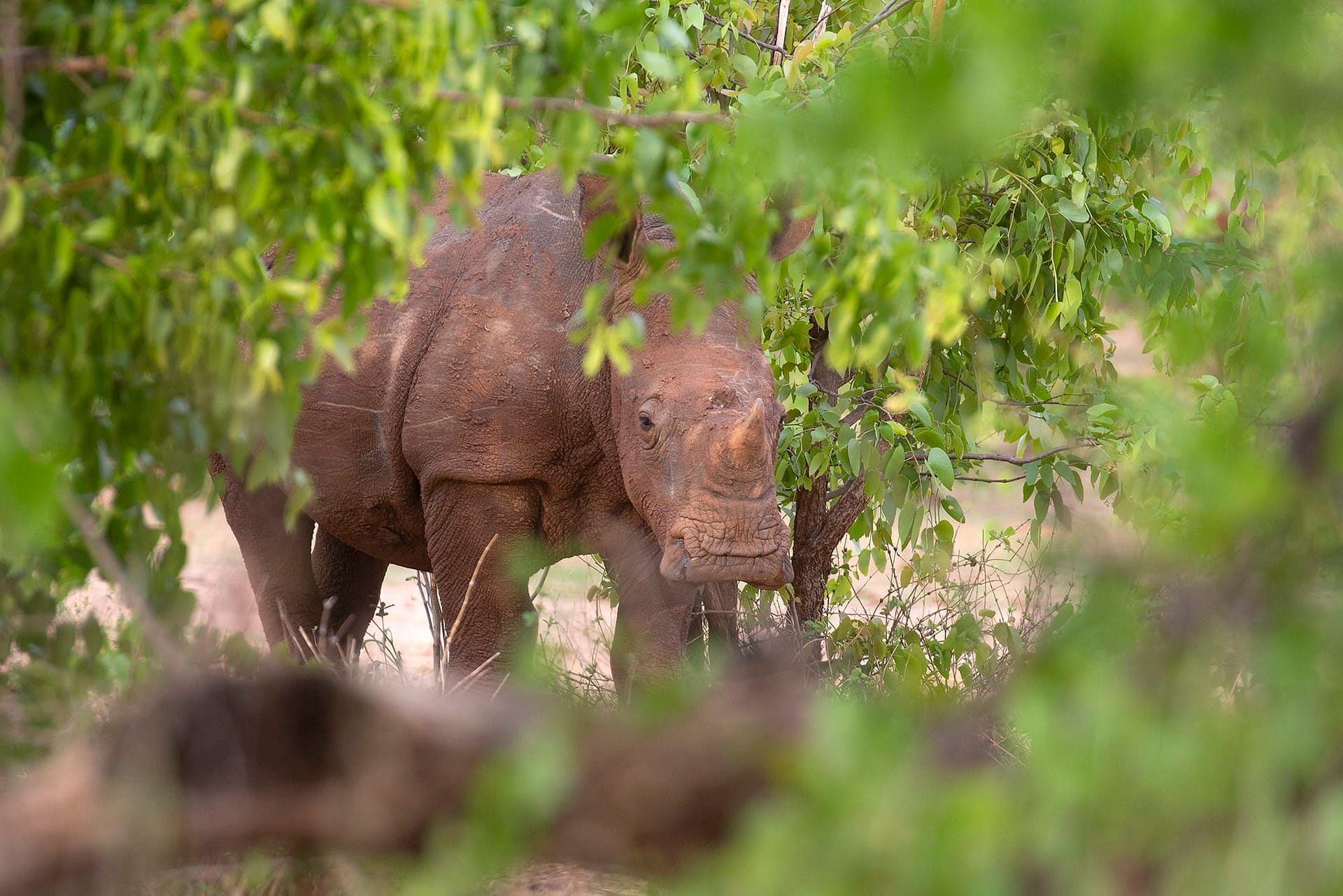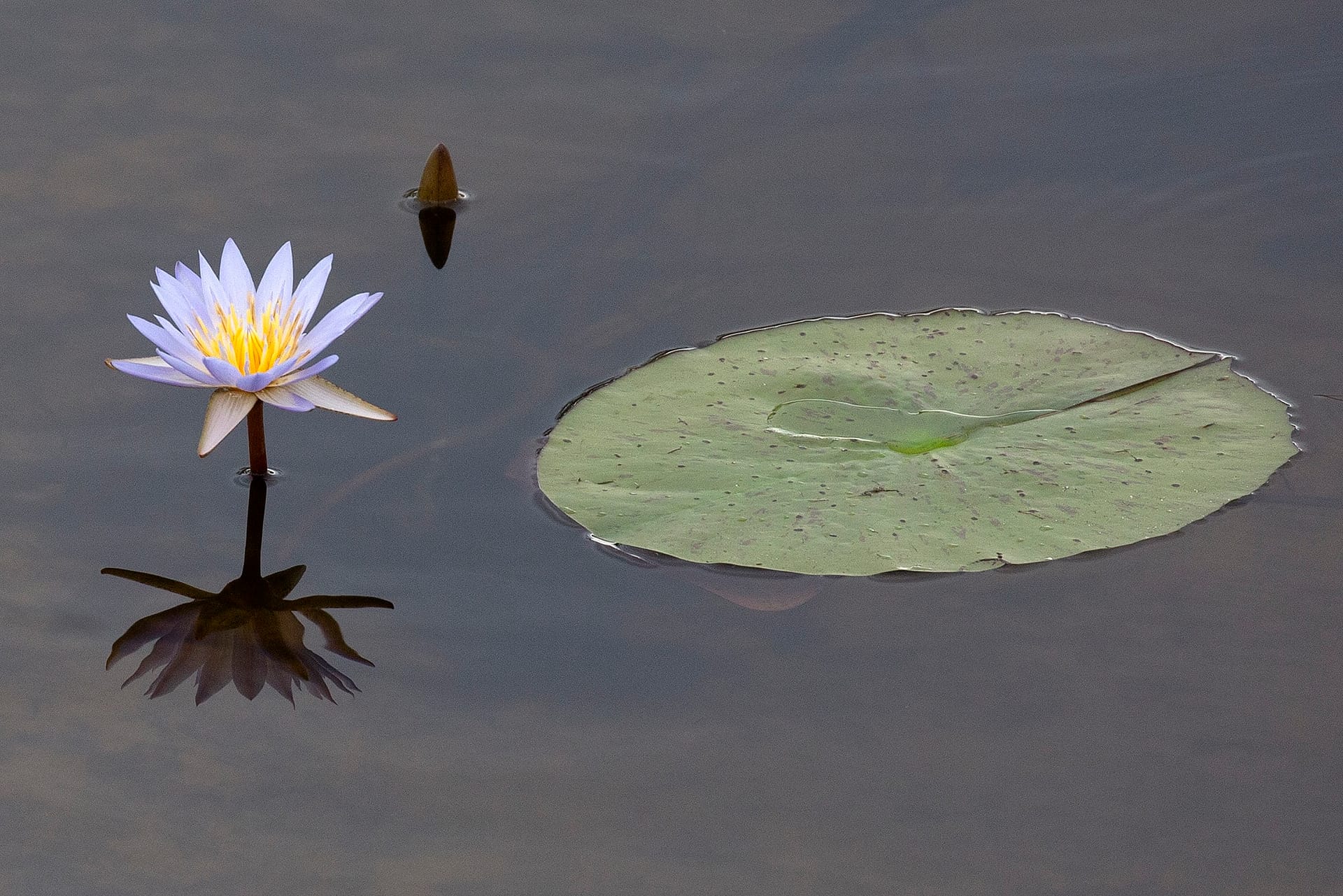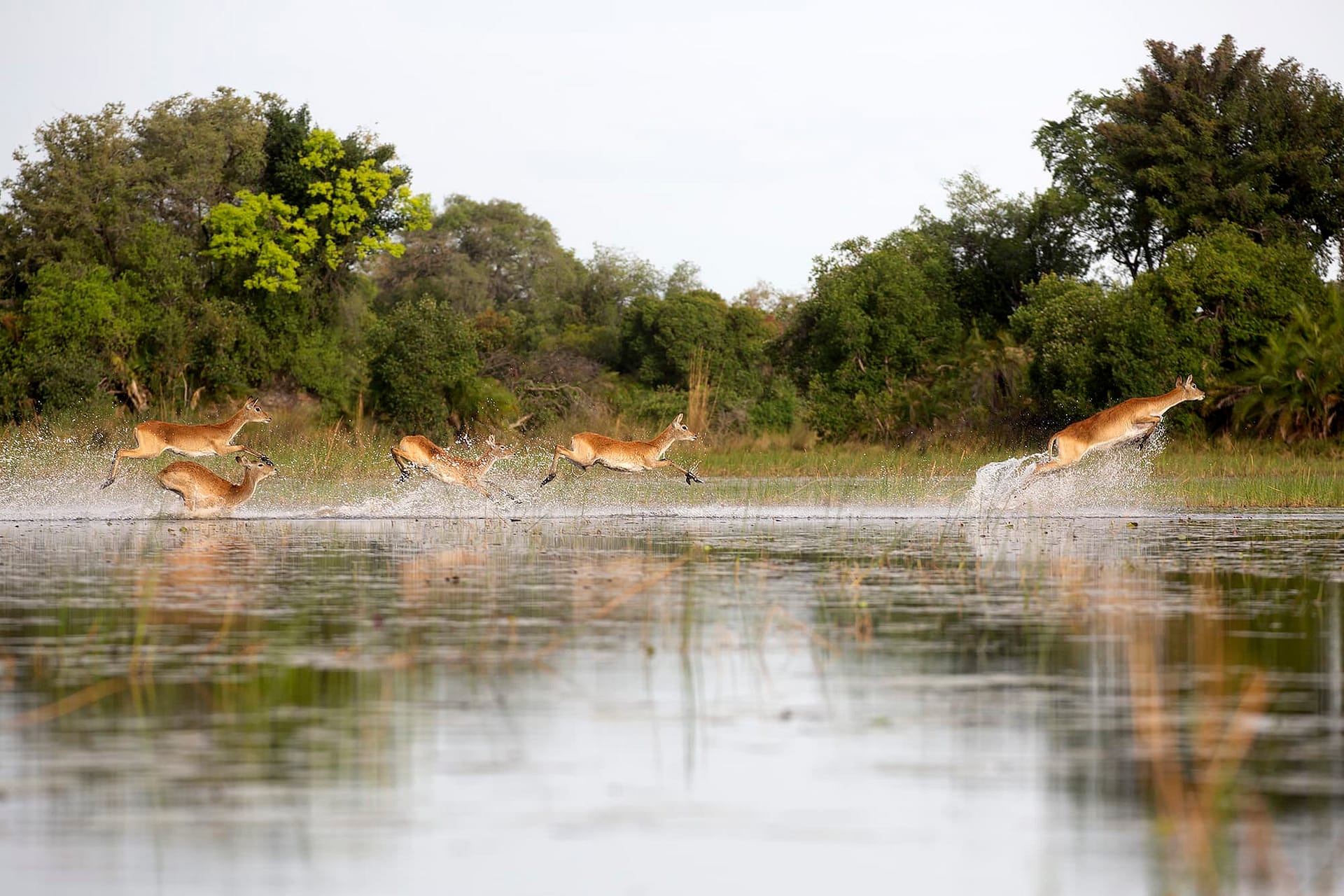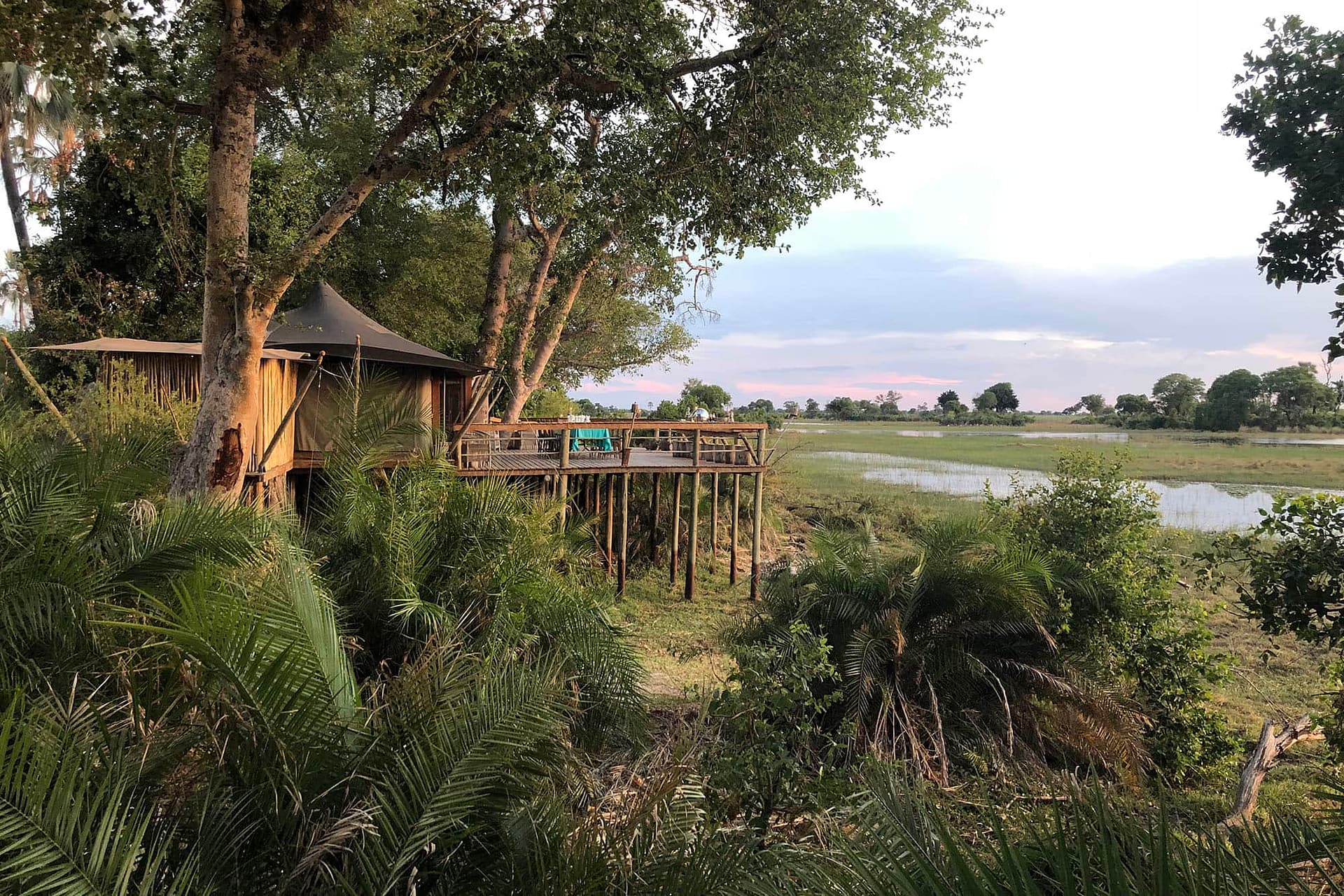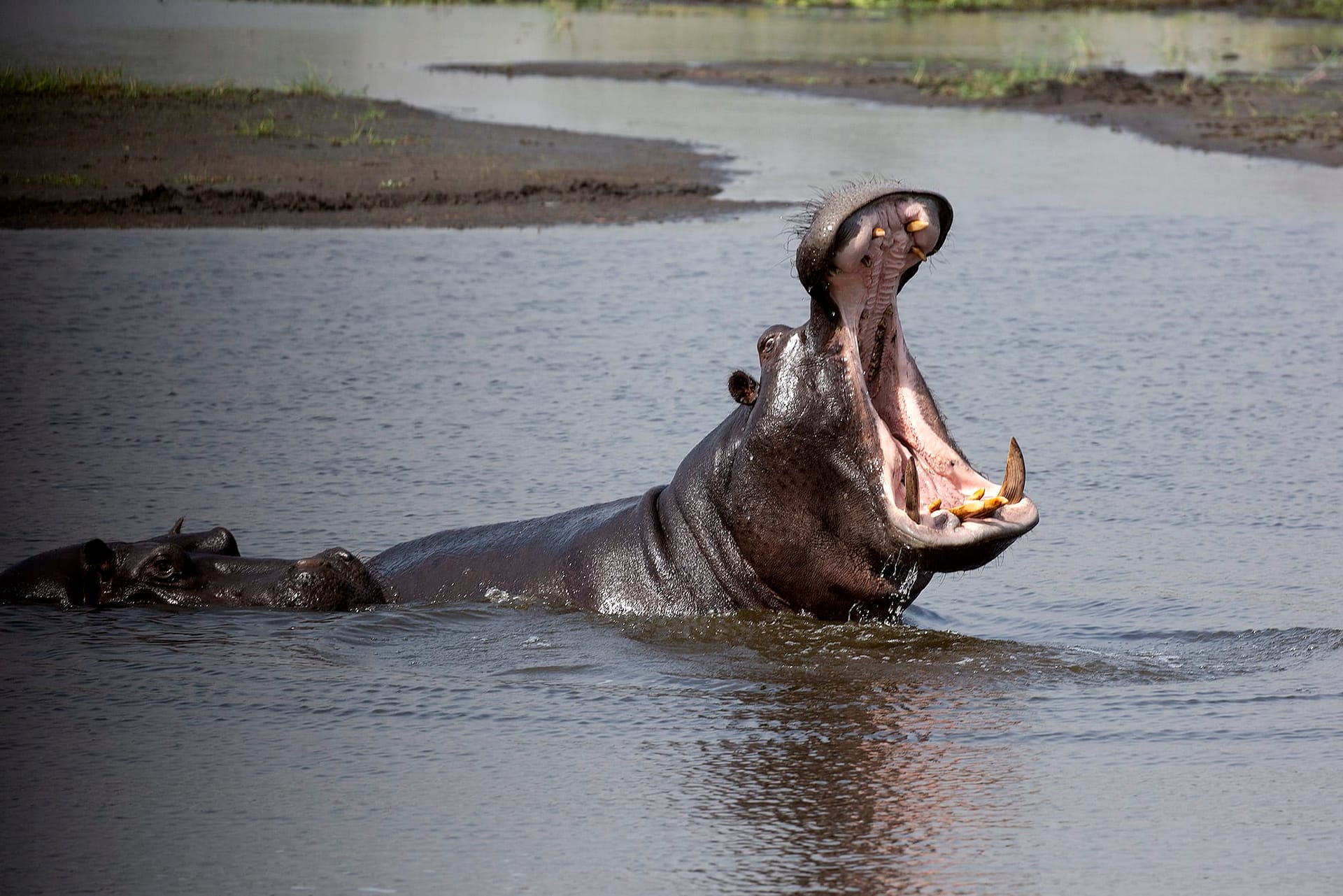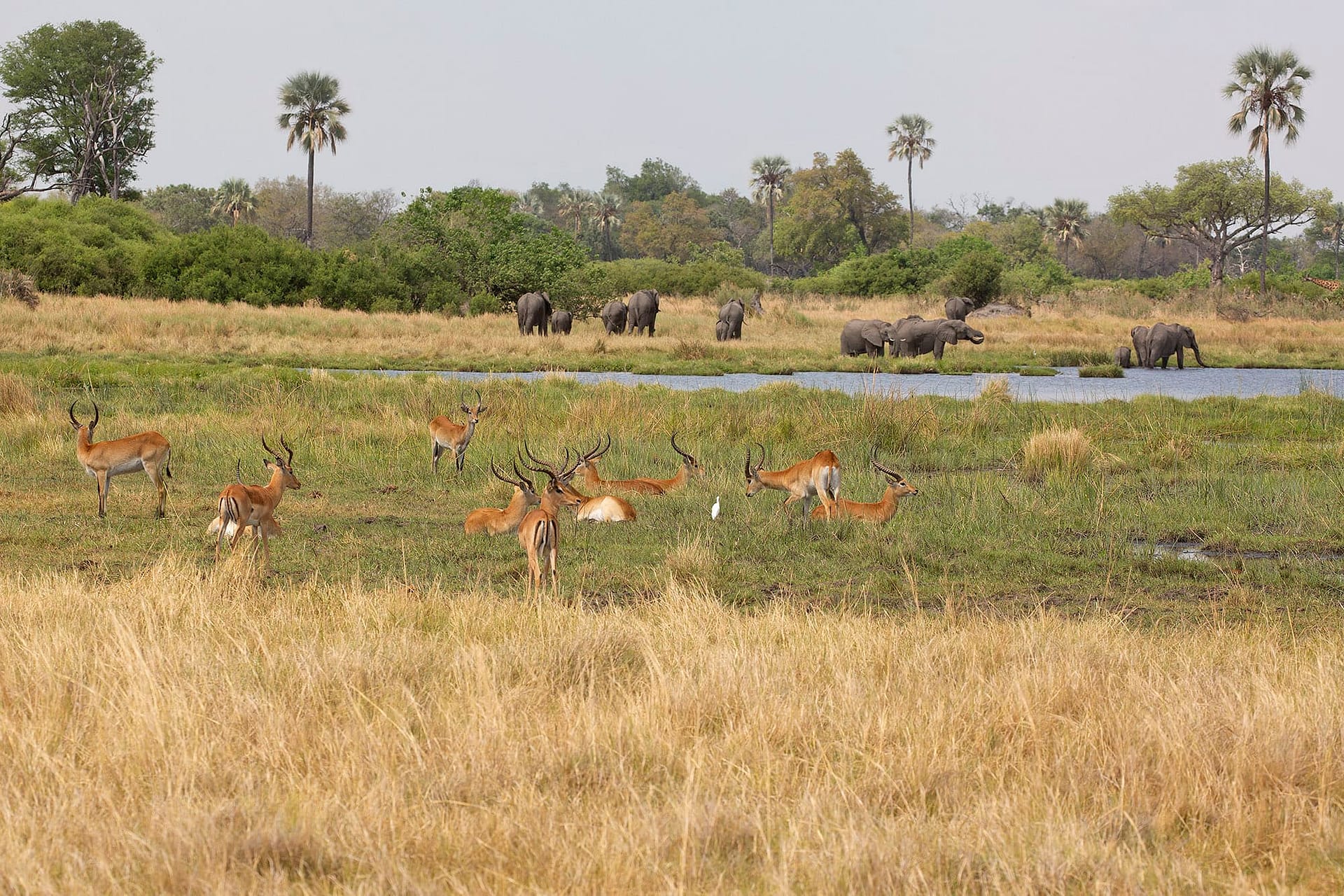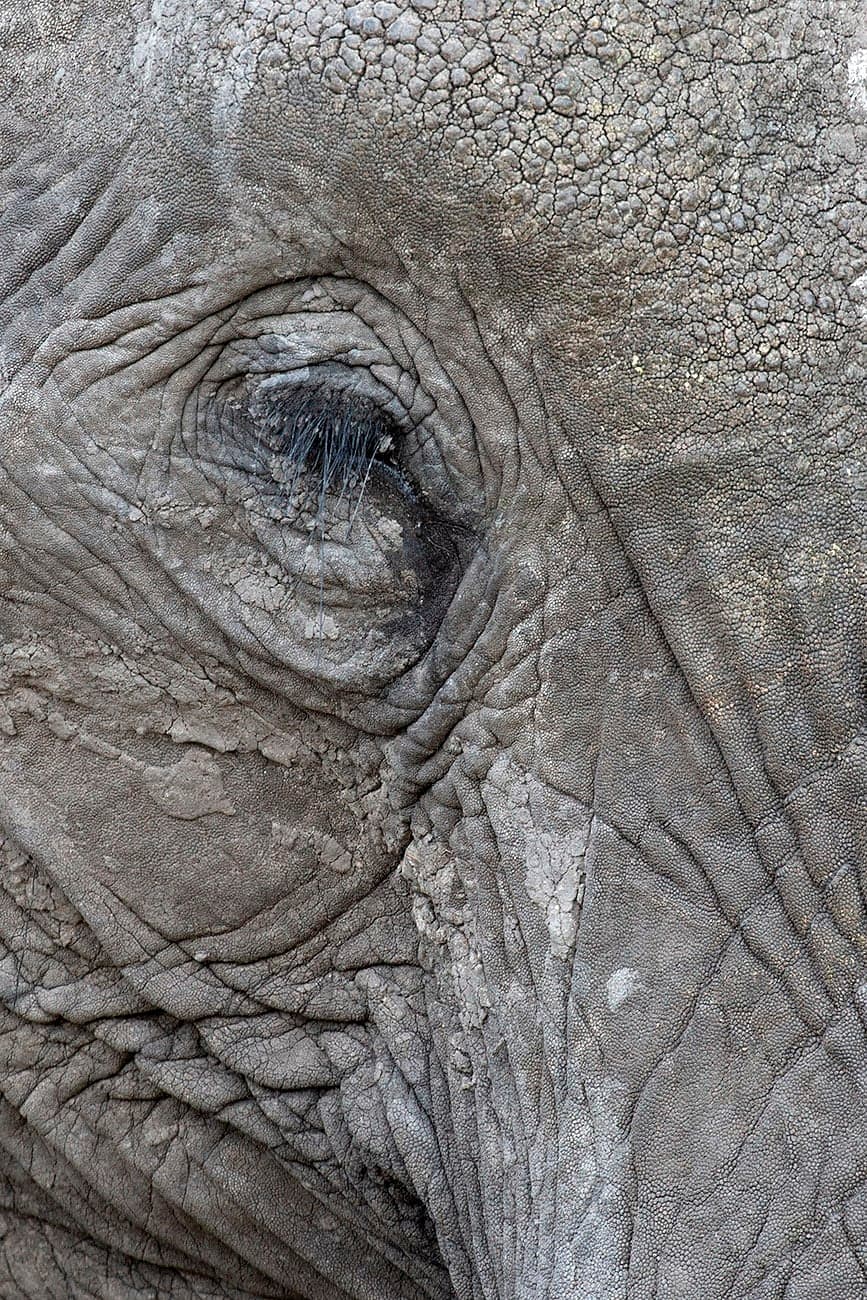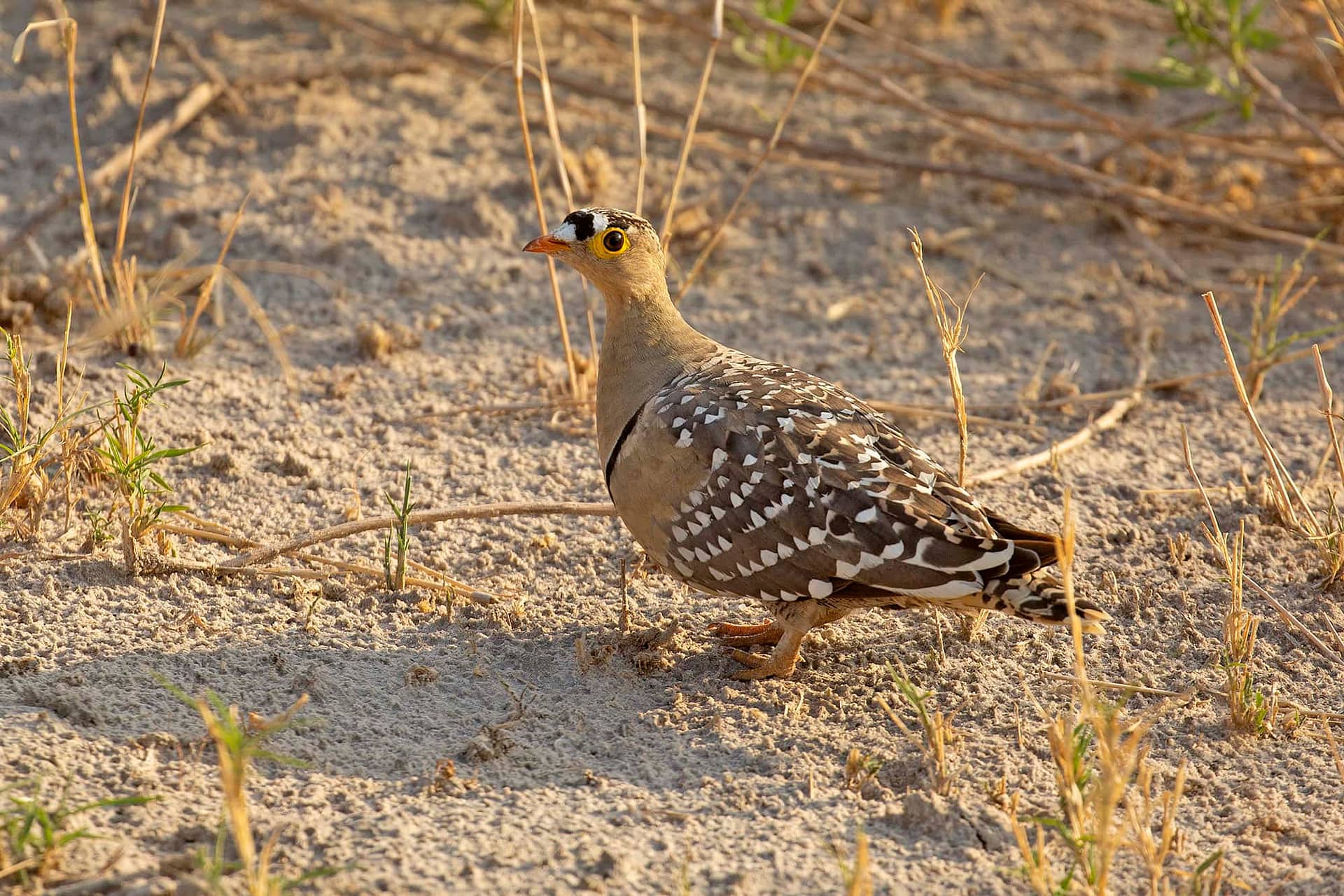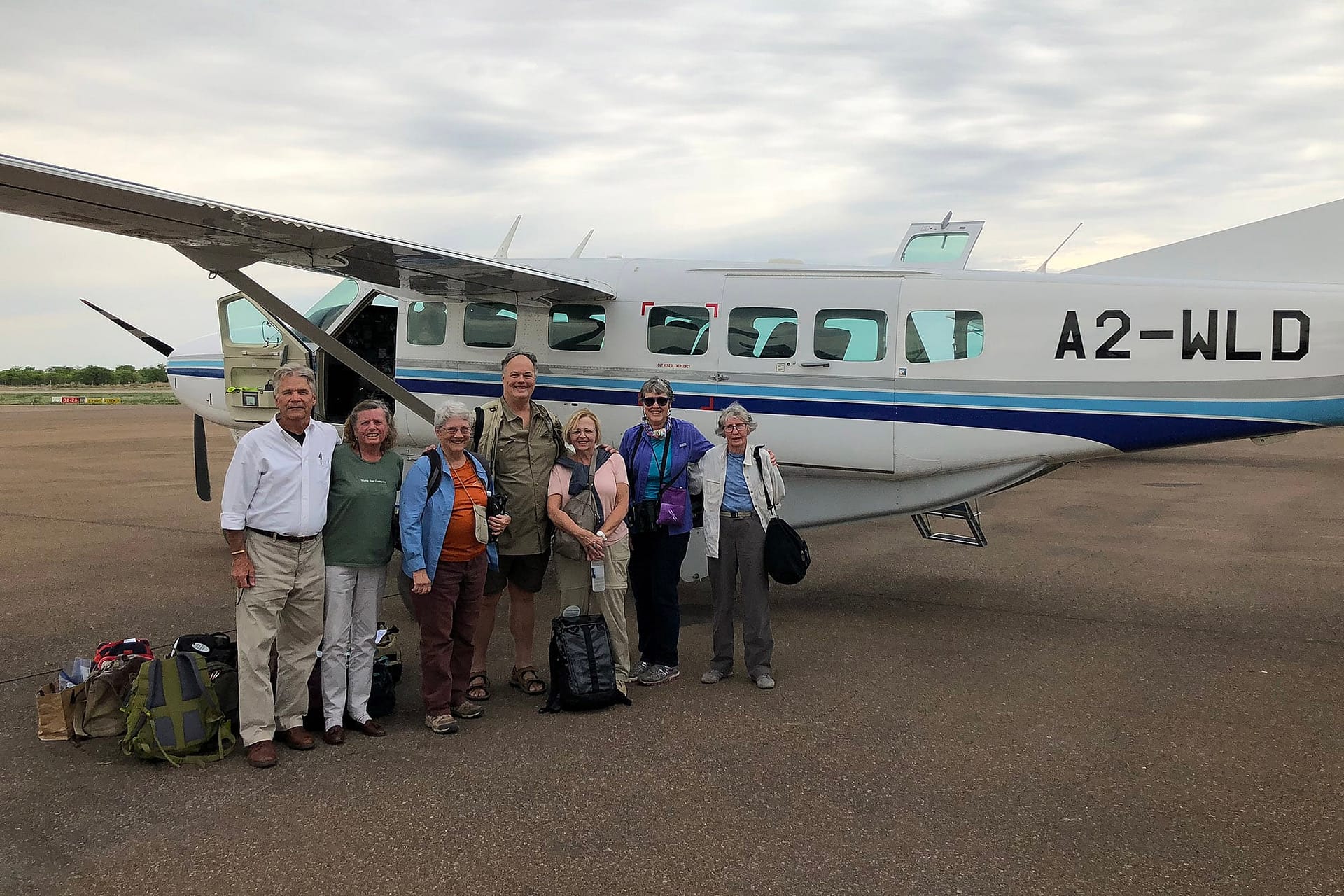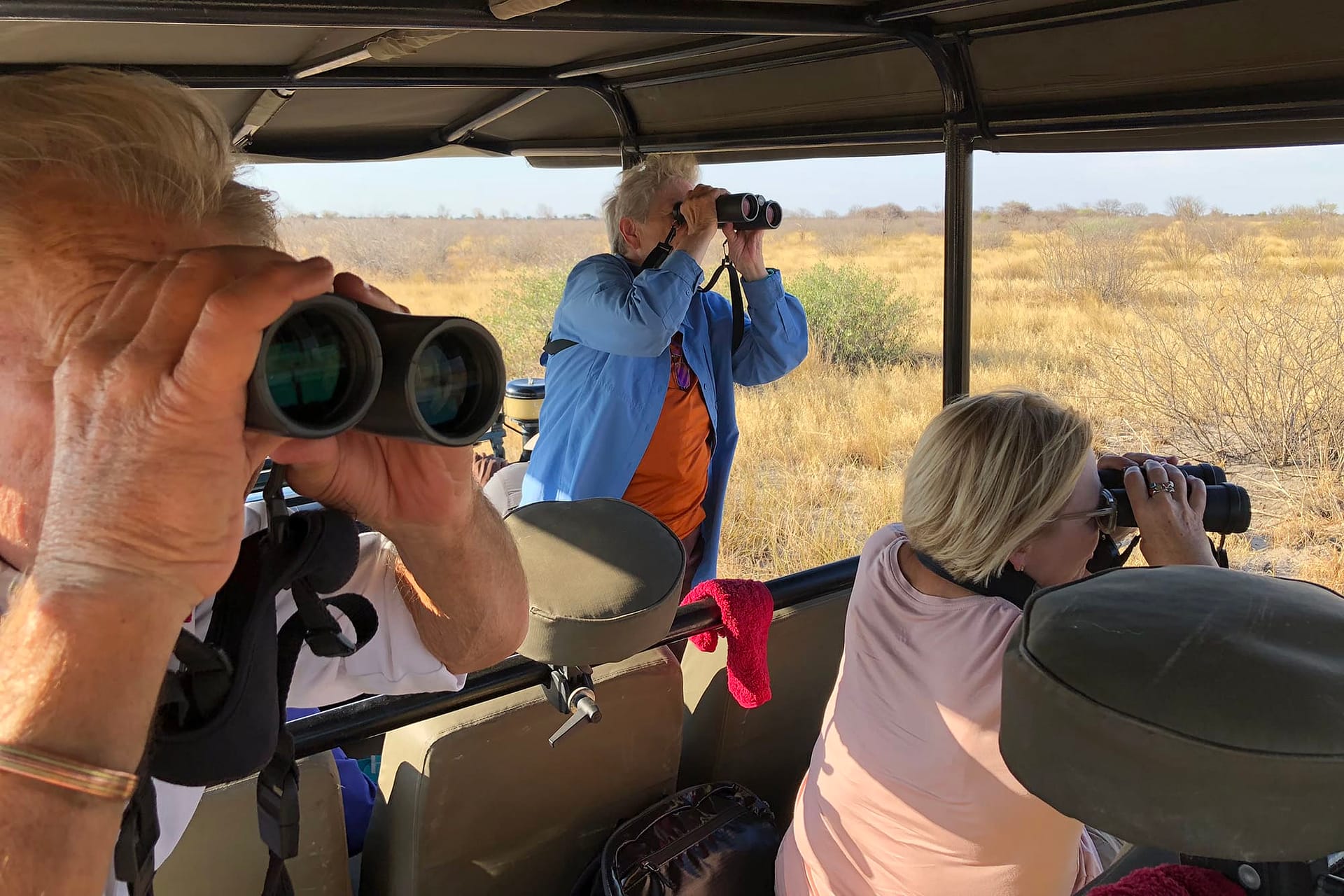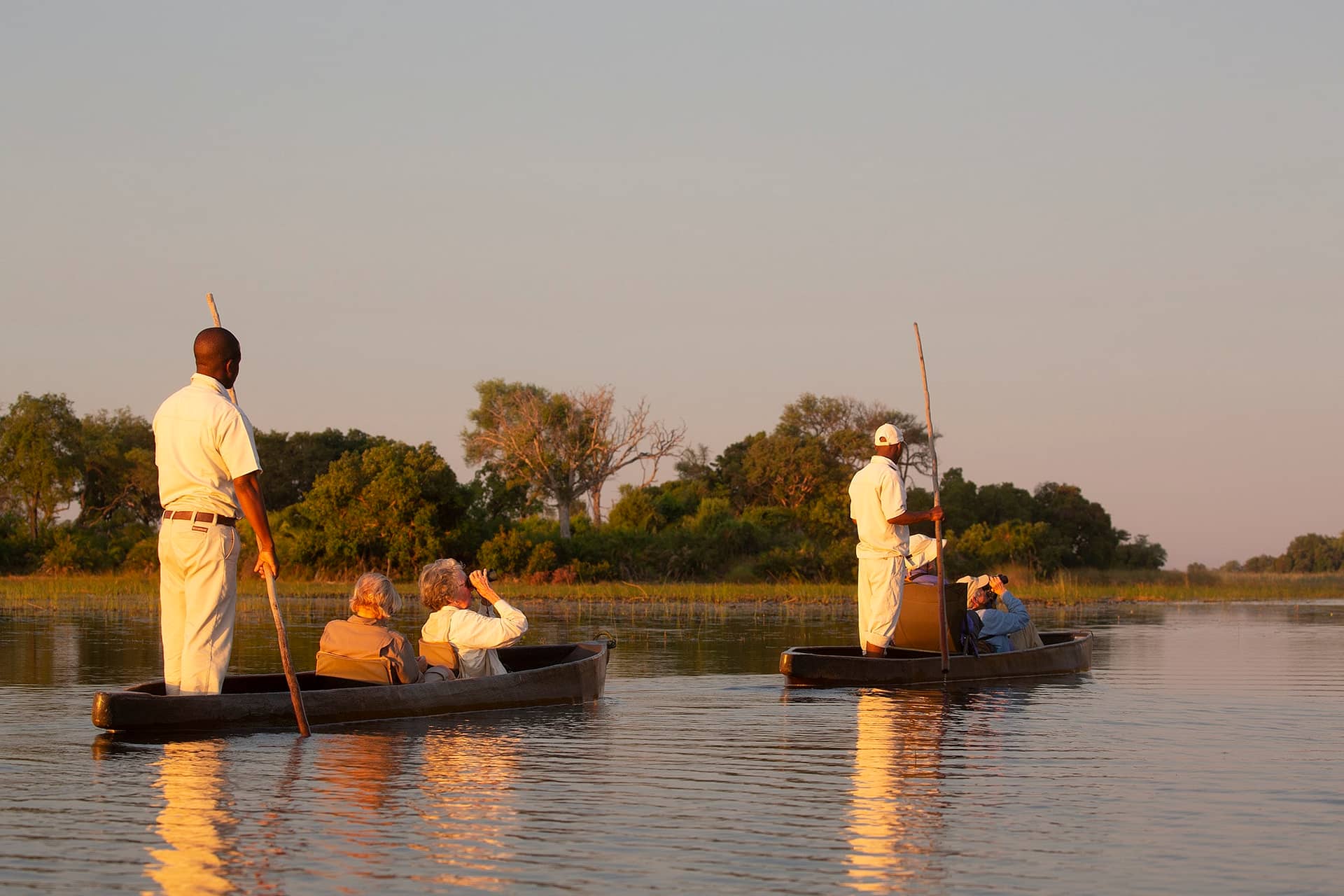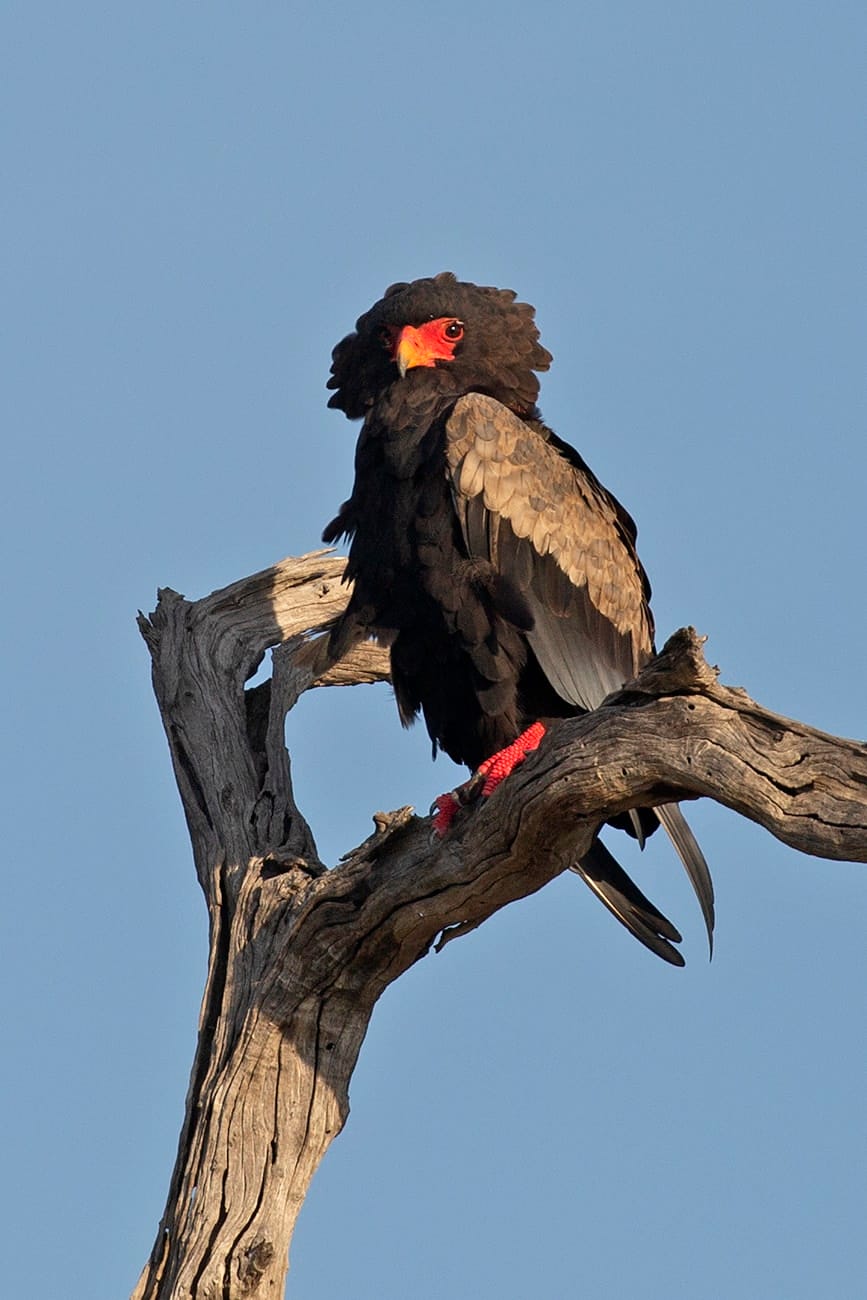TRIP REPORT: BOTSWANA & ZAMBIA – 2018 Nov-Dec – Wildlife Safari

TOUR FOCUS
TRIP LEADERS
PRIVATE TOUR OPTION
This tour is available as a private trip for any size group. The tour cost will vary with the number of people and any custom requests.
TESTIMONIALS
Trip report by Adrian Binns
Day 1 / Friday November 23 – Maun to Kalahari Plains Camp
Our Botswana safari actually began in Johannesburg, South Africa, where our entire group met-up to catch the late morning flight to Maun, Botswana. Upon arrival and clearing customs, we were whisked onto the tarmac for the first of seven puddle-jumper flights exploring multiple locations in Botswana and Victoria Falls. Within an hour we touched down onto the sparse desert landscape of the Kalahari Plains, located in central Botswana, and home to one of the largest conservation areas in the world. Amid the mid-day heat, we were cheerfully welcomed by our guide Kabo.
We stopped several times on the way to our Plains Camp, to enjoy our first looks at the region’s common and specialty birds, including Marico and Chat Flycatchers, Black-chested Prinia, Scaly-feathered Finch, Fawn-colored Lark, and Red-eyed Bulbul. We admired colorful Violet-eared Waxbill, Swallow-tailed Bee-eater, Brown-crowned Tchagra, Lesser Grey Shrike, Great Sparrow and Kalahari Scrub-Robin, alongside the plainer Southern Anteater Chat, Cape and Pied Crows. Red-crested Korhaans and stately Kori Bustards showed nicely, while the main raptor was Pale Chanting Goshawk. Our first mammal sightings included Steenbok, Springbok and Scrub Hare.
Indigenous Bushmen welcomed us with song to the Kalahari Plains Camp in late afternoon. In fading light, we admired cooperative Crimson-breasted Shrikes, Greater Kestrel, and Capped Wheatear. We watched two Southern Giraffes walk to the nearby watering hole, and several Honey Badgers foraging in short grass.
We enjoyed refreshing sundowners a bit later than usual, at the camp bar, while being serenaded by Fiery-necked Nightjars and numerous Barking Geckos. Our first day ended with an delicious dinner under the stars, while watching three Brown Hyaenas, usually quiet and solitary, vocalize and chase each other around the watering hole!
Day 2 / Saturday November 24 – Kalahari Plains Camp
On our first full day in the Kalahari, we awoke to the roar of lions and were thrilled to see eight in view at the edge of the large pan in front of our camp. Several Southern Giraffes and numerous Black-backed Jackals were warily eyeing the big cats. Water levels vary seasonally in this natural basin. Being the end of the dry season the made-made watering hole attracted myriad thirsty birds and animals into close proximity. We also saw the footprints of one lion that had walked up to the small bird bath besides the reception area.
We added Chestnut-vented Warbler, Pririt Batis, and Cape Starling to our bird list before heading out for our morning wildlife drive. While watching an aged Wildebeest, word came over the radio that Wild Dogs were at the watering hole. We drove quickly back to the pan to see a pack of nine dogs; adults lapped up water while younger ones hung back for safety.
We spent many hours scanning the pan during our visit, as this watering hole is the only source of water for 60 kilometers. Eventually, every animal must come here to drink – prey and predator species alike – providing exciting opportunities for wildlife watchers. We saw thousands of doves explode up from the pan, often chased by a Black-backed Jackal. A beautiful, male Grey-backed Sparrow alighted along the water’s edge, while a weary herd of Greater Kudu approached cautiously.
The habitat features a mix of seed-rich grasslands, shrubs, and acacia woodlands to sustain a variety of creatures. We watched Honey Badgers rummage through soft sandy soil, while Pale Chanting Goshawks stood by, patiently waiting their chance to grab insects, lizards or rodents that were fleeing the badgers.
While looking for the lion pride in an area of mixed scrub, we encountered Yellow Canary, Desert Cisticola, Southern Masked Weaver, Long-billed Crombec, and Acacia Pied Barbet. White-backed Vultures pecked at the remains of a Giraffe carcass. Two lizards, a Ground Agama and a Striped Skink captured our attention, too.
We stopped to stretch our legs and sip tea in a grove of open acacias. Avian activity highlighted Cape Penduline Tit, Cutthroat, Green-winged Pytilia, White-browed Sparrow-Weaver, Long-billed Crombec, Grey Hornbill, and many Scaly-feathered Finches amongst the thorny trees. A Secretary Bird stalked by, along with an Ostrich, Kori Bustard and Northern Black Korhaans. A pair of Bat-eared Foxes looked for insects in short grasses.
A stop at the watering hole on our way back to camp revealed a large congregation of a hundred White-backed Vultures with about a dozen Lappet-faced Vultures. With mid-day temps exceeding 100F, it was no surprise that the water bath attracted numerous Red-headed Finches, Straw-tailed Whydah, Red-eyed Bulbuls, Violet-eared Waxbill and Green-winged Pytilia.
During our afternoon break, we were entertained by the Bushmen demonstrating their traditional songs and games, including a tribal version of rock-paper-scissors accompanied by wonderful vocalizations.
Around 4pm we set out for a late-day wildlife drive marked with Red-billed Francolin, Rattling Cisticola, Red-backed Shrike, and Yellow Canary. The local pride of lions roused from their rest only to yawn, stretch, and walk a few yards before settling down into the scrub again.
We lingered over sundowners at the edge of the pan, watching a brilliant sunset. A Rufous-naped Lark sang in the background as bustards, korhaan and goshawk flew past. Back at camp, there was no time for showers before the show started, highlighting traditional dancing. Our day ended with dinner under the stars, marked by a Kudu alarm call alerting us to a huge, black-maned Lion at the watering hole. Yet another wonderful African safari experience!
Day 3 / Sunday November 25 – Kalahari Plains Camp to Chitabe
We enjoyed the morning scene at the wondrous watering hole. With no lions in sight, there were four Southern Giraffe, six Oryx (Gemsbok), seven Greater Kudu, 3 Honey Badger, an inquisitive Brown Hyaena and a Lanner Falcon feasting on a dove.
Our wildlife drive showcased the western edge of the pan, with good looks at Great Sparrow, Yellow Canary, and Kalahari Scrub Robin. We delighted in the number of Honey Badgers, including two in the company of a Black-backed Jackal and PCG’s (Pale Chanting Goshawks). A pair of Bat-eared Foxes and a Black-chested Snake-Eagle rounded-out the excursion. Back at camp, we packed, had brunch, and said goodbye to the wonderful staff. Kabo took us to the airstrip where we embarked on a one-hour flight north to Chitabe, on the edge of the Okavango Delta (with a very brief stop at Qorokwe to unload a passenger).
The flight from the Kalahari to the Okavango Delta reflects sharp contrast in scenery and habitats. We spend the next five nights – at two different camps – within the largest inland wetlands on earth, encompassing 15,000 square kms of watery paradise interlaced with papyrus, reeds, grassy floodplains, tree-covered islands and a network of winding water channels. This world-class wildlife destination features fascinating and diverse ecosystems, home to large numbers of mammals, birds, reptiles and other wildlife.
Landing in Chitabe, we were greeted by our guide Duke, then began a ride through the mosaic of shrub, woodland, and grassland. Situated at the southern side of the Okavango, Chitabe is a “dry camp” enabling travels by land vehicle. We stopped to see Meve’s Starling, Lilac-breasted Roller, Blue Waxbill, Southern Red-billed Hornbill, and Woodland Kingfisher. We encountered the first of many Southern Giraffe, including a mother babysitting six youngsters, and a few Kudu, Zebra, Wildebeest, and Tsessebe.
After checking-in to the Chitabe Camp, we were eager to explore more of this beautiful locale. Around our rooms, we found Arrow-marked Babbler, Black-collared Barbet, Meyer’s Parrots, and Broad-billed Rollers. Bushbuck ambled through the open camp. Fortified by afternoon tea, we embarked on our first Okavango Delta wildlife drive, looking for wetland birds. We got off to a wonderful start, seeing secretive Lesser Jacana walking on lily pads, Blacksmith and Long-toed Lapwings, Pied Kingfisher, Openbill, Black-winged Stilt, Hamerkop, Spur-winged Goose, Intermediate Egret, Slaty Egret, Yellow-billed Duck, stately Saddle-billed Storks, and African Fish Eagle. We found several Senegal Coucals and Red-billed Buffalo-Weavers moving around tall grasses. We spent time with a pride of lions, two females and six cubs, seeing Magpie Shrikes along the way.
This evening’s sundowners were greatly enjoyed with fleeting company of an Elephant sauntering by. The long, glorious day ended with a night game drive that yielded a Fiery-necked Nightjar.
Day 4 / Monday November 26 – Chitabe
This memorable morning we were alerted to the presence of Leopards, and bee-lined to the area. We learned that two Leopards – a mother and cub – had confronted another female Leopard. All had apparently moved on, but we found the lone female up a tree, after hearing Red-billed Francolin alarm calls. We noticed she had a slight open wound on her foreleg, and perhaps a belly injury. She descended into a thicket, though we were able to view her from various vantage points, before she moved in deeper.
Over the course of our morning drive, we found a nice assortment of birds, including Hartlaub’s Babbler, Wahlberg’s Eagle, Brown Snake-Eagle, Emerald Spotted Wood-Dove, Crested Francolin, Striped Kingfisher, Black-crowned Tchagra, and a migrant Great Spotted Cuckoo.
We settled at a watering hole for a couple hours, watching to see what would unfold. Our patience was rewarded with great sightings. Hippos wallowed in the deepest part of the pond, while Nile Crocodiles spread out around shallow edges. Impalas and Warthogs bravely ventured in to drink, as a lone Red Lechwe and several Southern Reedbucks stayed outside. Two herds of Elephants, 19 followed by 12, came into view, walking single file from one island to another, not stopping to drink.
Around the pond edges, we found African Snipe, Pink-backed Pelican, Hottentot Teal, Red-billed Duck, and Burchell’s Sandgrouse flying in for a drink. Shallows held many Marabou, and an assortment of actively-feeding waders: African Spoonbill, Yellow-billed Stork, Little and Great Egrets, Black-winged Stilts, Greenshank, Ruff, Marsh, and Wood Sandpiper. We keenly watched the interactions of a Puff Adder curled up in the water, and a curious Marabou. Each time the stork tried to pick it up, the snake would strike out and slither back. This went on for a while, looking like a stalemate. To our surprise, a 5-foot crocodile silently slid into the water and grabbed the Puff Adder in one bite, shaking it vigorously and splashing the waters until the snake was limp. The croc moved away and devoured it. This was truly a full African experience!
We took at tea break alongside a nearby marsh, amused by an African Darter perched on a Hippo’s back, staying put through occasional dunkings! A herd of Red Lechwe milled about the water, while a Comb Duck rested amongst White-faced Whistling Duck.
Heading back to camp for lunch, we came across a pair of Wattled Cranes with a juvenile wandering through a wet patch of grass. Enjoying our meal on the open deck, we could see a pair of Spotted-necked Otters swimming in the nearby channel.
Near the end of our mid-day break, darkening skies and thunder heralded the arrival of much-needed rains. We stayed around the camp’s open common areas, watching small flocks of Black Herons fly-by between short breaks in the storm. We were delighted to discover a Yellow Bat roosting over the bar! Along the boardwalk we found Broad-billed Roller, Hartlaub’s and Arrow-marked Babblers, Crested Barbet, Woodland Kingfisher, and a stunning Bennet’s Woodpecker.
When rain abated, we managed a short wildlife drive before dark, seeing a Kurrichane Thrush, and a large herd of several hundred Buffalo. At an expansive pool and marshy area we enjoyed our usual sundowners, while watching yawning hippos and Black Crakes, along with Sacred Ibis and White-faced Whistling-Ducks flying to roost.
Day 5 / Tuesday November 27 – Chitabe
This morning we headed northeast towards the Gomoti Channel; a Spotted Hyaena carrying some kind of leg in its mouth was an early highlight! Raptors showed well, beginning with a Pearl-spotted Owlet followed by African Fish Eagle, Tawny Eagle, Lesser Spotted Eagle, Brown Snake-Eagle and numerous Bateleurs soaring overhead.
At the airstrip, multiple puddles from recent rains attracted bathing Scaly-feathered Finches, Green-winged Pytillia, Southern Grey-headed Sparrow, Shat-tailed Whydah and Southern Pied Babblers. The surrounding shrubs held Neddicky, Crimson-breasted Shrike, Cardinal Woodpecker and Common Scimitarbill, along with a pair of Double-banded Sandgrouse and Swainson’s Spurfowls foraging at the bases.
The Gomoti Channel forms the eastern boundary of the concession with Moremi Game Reserve being on the opposite side. We wound our way along the water course, much of it very narrow and shallow with a broad swathe of lush short green grass on either side. An assortment of waterbirds held our attention, including Openbills, Black-winged Stilt, Reed Cormorant, Hadada Ibis, Glossy Ibis, Goliath Heron and Water Thick-knee, the latter five new for the trip. Red Lechwe were the dominate ungulates, keeping company with a few Impala, Chacma Baboons, Warthogs, Reedbuck, Zebra and Wildebeest. In one pool, two bull Hippos flashed their sharp tusks in half-hearted aggression at our appearance. Three young Lions lounged on a termite mound, a perfect spot to scan the landscape and repose. We were stopped in our tracks by a large bull Elephant blocking the way as it fed on the tender leaves of a sausage tree, breaking off major branches as if they were twigs with his powerful trunk.
On the return journey we stopped for many Southern Giraffes, along with several Dickinson’s Kestrel, a Crested Barbet, African Hoopoe and Swallow-tailed Bee-eater. We were delightfully surprised by the bush lunch setup for us in the field – a wonderful treat after a long morning game drive. We relaxed over the delicious food and humorous poses of our cameraman, Moppat, who was tasked with taking our group photo, but found more fun in contorting himself and the camera in odd angles! The meal ended with an old bull Elephant coming down to drink. Our short journey back to camp was punctuated with stops for a pair of Wattled Cranes feeding near Saddle-billed Storks, and Jameson’s Firefinches.
After our siesta during a very warm mid afternoon, we congregated for high tea featuring fresh mint sorbet to energize us for the afternoon exploration. The nearby wetland was most active with a pair of Wattled Cranes, Sacred Ibis, and half a dozen African Openbills all posing with wings cupped. John mused that perhaps they were looking for handouts?! Magpie Shrike and Striped Kingfisher are always lovely to see, and White-browed Coucals and a Southern Black Flycatcher were new trip birds. We enjoyed watching three adult Ostriches and their seven young offspring strutting along the sandy track, before making a beeline away from us, kicking up sand as they went.
Against the backdrop of a beautiful sunset, we tuned into the tummy rumbling sounds of an elephant, and soon found a herd of them. We quietly watched a mother stripping the bark off a tree, while her youngster took note of this behavior. One boisterous teenage elephant came up behind our vehicle, flapping his ears with displeasure at our presence.
Our third night drive at Chitabe was a great success with Small-spotted Genet and African Civet seen well by all, as we drove back to camp in the dark. We enjoyed our last dinner outside in the boma, serenaded by staff singing lovely harmonies.
Day 6 / Wednesday November 28 – Chitabe to Pelo Camp
Just after first light this morning, I found a Verreaux’s Eagle Owl at the end of the boardwalk. Others hurried over to see and hear it call before it headed off to roost, and we walked to breakfast.
After breakfast we drove a short distance out of camp to our location for a bush walk. On the way, our guide Duke spotted telltale prints in the sandy track of an Impala being dragged by a Leopard! Unfortunately, we could not locate the big cat, though the tracks looked quite fresh. We enjoyed a fascinating hour-long walk, seeing a baby Impala that had been left in safe hiding by its mother while she went out to feed, as well as alert Zebra, and a curious Giraffe. Duke pointed out various tracks along the way, including those of Giraffe, Kudu, Spotted Hyaena, Honey Badger, and an impressively huge elephant print. We examined Giraffe pellets and fresh Elephant dung full of ilala palm fruit, which Termites were already attacking. Flora was just as interesting, as we admired delicate flowers and smelled Wild Sage, a good insect repellent. We came across some remains of an Elephant – a pile of bones and a single 30” tusk weighing about 12 pounds. Duke explained how the huge skull is a honeycomb structure and actually weighs less than the bones. We sighted several birds including Crested Barbet, Hoopoe, Yellow-breasted Apalis and Red-billed Hornbills and an unidentified Cuckoo. A Black-backed Puffback and Southern Carmine Bee-eater flitted in and around the camp.
Our late morning flight from Chitabe to Jao took about 45 minutes including a stop at Qorokwe. Our small plane stayed fairly low in the air, providing views of Elephants in the water and a flock of Woolly-necked Storks flying across the landscape. Jakes greeted our landing, and drove us through the Jao Preserve to Pelo Camp in the northwestern area of the Okavango Delta. We drove for about an hour, stopping occasionally along the way to admire Impalas and Red Lechwe, along with Slaty Egret, Wattled Cranes, Collared Pratincole, Black Crake and both Chirping and Luapula Cisticola. In areas of short grasses we found African Stonechat, Temminck’s Coursers and Brown Firefinches.
For the final leg of the journey we took a short boat ride to Pelo, a water camp situated on a palm island overlooking a large open body of water. Depending on water levels, the driving and boating legs of the journey from airplane to camp can vary in length; we were heading into the dry season with water levels receding, so our boat journey was short this time. Jacques provided a wonderful introduction to the camp before an excellent lunch. We then settled into our rooms for a break before heading out for the afternoon activity – a mokoro boat ride in the delta!
Letty, System, Twist and Jakes poled our four mokoros, respectively – memorable names for great guides on the waterway. For several hours we enjoyed a tranquil glide through the delta, following deep channels made by hippos. African Jacana and Squacco Heron were the most numerous wader along with many Reed (Long-tailed) Cormorants. Pairs of African Pygmy Geese flushed from the water lilies, and we enjoyed good views of Water Thick-knees, Green-backed Heron and Malachite Kingfisher hunting along the river banks. Flying overhead were African Green Pigeons, Whiskered Terns, African Skimmers and African Marsh Harrier. At the Sand Bank we got out to stretch our legs and enjoy our daily ritual of sundowners while watching several Sitatunga in the water and three Elephants who couldn’t decide which side of the channel they preferred, after crossing over then returning back.
Dinner was most spectacular on the camp deck, under the stars, with a continuous lightening show in the distance. The evening was complete when a Pel’s Fishing Owl flew right by our table!
Day 7 / Thursday November 29 – Pelo Camp
A strong storm had come through overnight, clearing by dawn, but leaving winds that rocked palm trees from side to side. Above the main deck African Green Pigeons and Dark-capped Bulbuls fed on the fruiting ficus, while a Southern Brown-throated Weaver foraged around the dinning tent, and Sitatunga stood in knee deep water.
This morning we journeyed by vehicle on land for about an hour, finding a variety of species on the outbound and return trips, including Coppery-tailed Coucal, Blue-cheeked Bee-eater, Meyer’s Parrot, Water Thick-knee, Icterine Warbler, Collared Pratincole, Plain-backed Pipit, and Rufous-naped Lark. Of interest were perfectly lined mole hills that led towards the marsh, made by Damaraland Mole Rats.
The land gave way to water, where we loaded into a motor boat for Jakes to guide a 3-hour ride through the aptly named Kubu Lagoon – Kubu being the Tswana name for hippo, which were plentiful. We first came across a young disgruntled male that sped out of the water surprisingly fast upon seeing us. Next was a large pod of hippos that opened their mouths wide to reveal huge teeth as we approached. We heard a lion roaring close by, and watched pairs of African Fish Eagles flicking their heads back and forth in interesting duets.
Amongst the papyrus a Chirping Cisticola sang loudly while a Lesser Swamp Warbler picked-up material for a nest. Many Malachite Kingfishers perched on waving papyrus stems while hunting. Along the edges of the wetland Fan-tailed Widowbird, Southern Masked and Spectacled Weavers showed while a few Purple Herons stood patiently before deciding to take off. A pair of Giant Kingfisher alighted in a tree as we passed by, and we craned our necks backwards to admire this largest member of the kingfisher family. A lone Banded Martin hawked insects low over the water. Water Monitors and Nile Crocodiles basked on the riverbanks and sand bars, while a Black Crake called a warning that a croc was near!
We returned to camp for the usual mid-day break. Our high tea was interrupted when Twist found an immature Pel’s Fishing Owl, the star species of this camp, and difficult to find elsewhere. We were thrilled to see this secretive ginger-colored owl roosting in a tree on the edge of the island about 300 meters from where it was born just five months ago.
In the last hours of the afternoon, we went by mokoro towards the front of the island. We spotted the young Pel’s Fishing Owl perched on an open branch, discerning a mix of immature and adult plumage in the bold light. African Pygmy Geese held still as a herd of Red Lechwe leapt through the water. Our mokoro polers set up a bar in the shallow lagoon – a gorgeous setting to enjoy sundowners, a special owl, and antelopes! Back at camp, hundreds of Barn Swallows, a few African Palm Swifts and a couple of Broad-billed Rollers were swarming and feasting on a termite hatch.
Day 8 / Friday November 30 – Pelo Camp to Savuti
We spent our last morning at the Pelo water camp birding around the main area where fruiting ficus trees attracted Lesser Honeyguide, African Green Pigeon, Greater Blue-eared Starling, Yellow-fronted Tinkerbird, Black-collared Barbet, Willow Warbler, Cardinal Woodpecker, Ashy Flycatchers, Grosbeak Weaver and Southern Brown-throated Weaver.
After a late breakfast we said goodbye to the staff and guides, and departed the water camp by boat, heading to our vehicle. For the remainder of the morning we drove through scrub savannah, admiring views of Long-crested Eagle, Brown Snake-Eagle, Collared Pratincole, Crested Barbet, Common Waxbill, Burchell’s Starling and Green Wood-Hoopoes poking bark for wood borer caterpillars. At various bridges the marshes held Hamerkop, Slaty Egrets, Luapula Cisticola, Black Crake and Rufous-bellied Heron.
We watched a band of Banded Mongoose puzzle over a narrow strip of water before deciding to jump over it. A Dung Beetle struggle to roll a fresh Lechwe pellet that was oddly-shaped like a biscuit, and not easy to push uphill!
Jakes, our faithful paddler and driver, saw us off at the Jao airstrip, where the pilot abruptly pulled back the first take-off attempt, when an Impala strolled across the runway. Eventually we were airborne, and an hour later, after a brief stop at Vumbara for other passengers, we landed at Chobe. There we were warmly met by Kevin who drove us the half-hour to Savuti Camp, our base for three nights.
Elephants were everywhere as we pulled in, providing a wonderful Savuti welcome! 150 animals stood in the channel just off of the deck; a bull happily stripped mopane leaves over the walkway, blocking our way to lunch until Newman, the camp manager, talked him into moving along!
After a refreshing meal, we embarked on the afternoon wildlife drive and soon found eleven Wild Dogs, 6 adults and 5 youngsters, resting in the shade. The adults soon got up to hunt, and left the pups behind. We caught up with some dogs, but nothing seemed to have happened, as they were listening for pack signals or potential prey to hunt. One lone dog was staring around, listening attentively for her pack mates; we watched her move on with with her head stretched low and making deep hoot sounds to connect with her pack. Eventually she sat in an open grasslands, and the rest of the pack appeared, pups too, and joined her in a wide circle.
While watching the fascinating pack behavior of Wild Dogs, we ticked a new mammal species for the trip, Common Waterbuck. A female Impala was babysitting a small nursery of half a dozen youngsters, while Hooded Vultures hung near the dogs just in case they managed a hunt.
Day 9 / Saturday December 1 – Savuti
This morning we enjoyed sunrise on the deck, with tea, coffee, and a fly-by Jacobin Cuckoo. Breakfast was packed for a picnic in the field, and we departed early to drive the east edge of the Savuti Channel, where Elephants dominated the scene. We came face-to-face with a herd of eight that walked right past our vehicle, then watched more than 80 feeding in the water channel, including a massive bull, a mother and her boisterous youngster staring us down, and a day-old calf on wobbly feet, staying close to her mother.
We picked up several new birds and appreciated better looks at others such as Rufous-bellied Heron, Comb Duck, African Marsh Harrier, Tawny Eagle, Magpie Shrike, Goliath Heron and Red-billed Queleas.
An Ayer’s Hawk-Eagle circled above us as a Black-headed Oriole called nearby. While backing up for better views of the oriole, we saw a Roan Antelope directly in our path! Kevin showed us hippo bones and its massive jaws on tusks.
This afternoon we headed into the mopane woodland in search of Arnott’s Chat, and a known pride of Lions. We couldn’t locate either, but a male Coqui Francolin along the track was a new find. We heard a Red-crested Korhaan calling to attract a female, and saw Double-banded Sandgrouse, Dickinson’s Kestrel, Rufous-naped and Fawn-coloured Larks. Burchell’s Starlings, Southern Red-billed Hornbills and Ring-necked Doves were abundant. We spotted White-backed Vultures circling overhead, joined by a Tawny Eagle, Bateleurs and Yellow-billed Kites all descending onto the remains of an Impala.
Kevin set up our sundowner next to a marsh where hippos wallowed, and a pair of roosting African Fish Eagles exchanged evening yodels. The evening was topped off with yet another herd of Elephants ambling towards us, providing wonderful up-close views while we were relaxing on foot.
Day 10 / Sunday December 2 – Savuti
With picnic breakfasts in hand, we set out this morning for the western side of the Savuti channel. It took a while, but we added three new species to our list: Yellow-throated Petronia, Golden-breasted Bunting, and a Black Cuckoo being mobbed by Fork-tailed Drongos. Broad-billed Rollers showed well, along with their Lilac-breasted cousins. An immature African Hawk-Eagle circled overhead as we munched our meal. On the way back to camp we enjoyed watching Warthogs feeding beside the track, and a Verreaux’ Eagle-Owl found by Kevin.
Back in the bush, we found the lion pride we had been seeking yesterday – 5 males and 6 females lazing together by the water channel. We watched a young Elephant approach and confront them with ears flapping, getting them up and moving. Over the next several hours, more than a thousand Elephants descended upon the marsh to drink, bathe, and move across the channel. Herds of 20, 30 or more came in, ranging in size from baby to huge bulls. Just meters away, the lions kept a watchful eye on the Elephants the entire time.
While the spectacle of elephants and lions was captivating, we watched another interesting scene play-out in the marsh, involving a Nile Crocodile pushing a dead baby hippo, possibly one it had killed, through the rushes. A little while later, we saw an adult hippo (presumably the parent) pushing the carcass towards the vegetated bank. The croc reappeared, inching its way towards them. It grabbed the carcass, and eased its way backwards away from the adult hippo. There was no fight, as the reptile had clearly won it’s prize.
A short afternoon drive produced Southern Carmine Bee-eater, Rufous-bellied Heron, a small band of Dwarf Mongoose and two male Lions known as the Channel Boys. We sat for an early dinner in order to go out on a night game drive. For nearly two hours we enjoyed seeing a great variety of nocturnal activity. A pride of active lions were in full hunting mode, emerging stealthily from shrubs, and even brushing past our vehicle before disappearing back into vegetation. Several hippos and wildebeest were lucky the lions switched direction, as both could’ve been meal targets. Later, we were forced to drive around two lions sleeping in the middle of the track – they never even lifted their heads! A few comical Spring Hares bouncing through the grasses, along with Square-tailed Nightjars rounded out a wonderful nighttime experience. Back at camp, two African Barred Owlets were spotted standing side by side, and lions roared in the background as we settled into our beds after a wonderful day on safari.
Day 11 / Monday December 3 – Savuti to Toka Leya
We spent our final morning at Savuti, in search of Bradfield’s Hornbill, a specialty of this area’s habitat. We managed to find the bird, but got ourselves stuck in soft sand. Never a dull moment on safari! Several Bateleurs were a beautiful sight, perched in a tree, showing red bill and legs, along with distinctive puffed-out feathers around the head.
We thoroughly enjoyed an hour’s walk with Kevin and Reuben, the tracker-guide from King’s Pool. In the open woodland we found Broad-billed Roller, Common Scimitarbill, Bennett’s Woodpecker, Myer’s Parrot, Crested Barbet and Brubru. Rueben pointed out interesting little things that are hard to see when driving in a vehicle, like the strong scent of a dried Basil seed, and the coin-sized hole in the middle of a Baboon Spider’s spun-silk web. Baboon droppings on a termite mound provide fertile ground for fruit seeds to sprout, which explained why we often saw trees growing out of termite mounds. We learned that elephants and termites are keystone species, providing critical services for the African eco-system to thrive. Elephant dung is efficiently processed by termites who turn it into piles that get covered in hard sand. Many termites are sensitive to the sun, and such piles make crucial shade. It was fascinating to walk through the landscape focusing on small stuff!
By mid morning we were back at camp, where we packed-up, ate brunch, and said good-bye to staff before heading to the Chobe airstrip for our flight to Kasane.
After a 45-minute flight to Kasane, we cleared customs to prepare for entry into Zambia. One last puddle-jumper plane took us out of Botswana and into Livingstone, Zambia in 20 minutes. Jeff met us for the short ride to Toka Leya, our base for exploring Victoria Falls and the Zambezi River. Once we settled in Godfrey, our guide and boatman, took us for a leisure ride down the mighty Zambezi. The river was big in spirit, if not in water, as a short stretch of rapids was our mightiest moment.
The waterway highlighted breath-taking views and wonderful birds and wildlife. Rock Pratincoles sat serenely atop volcanic rocks that protrude along the rapids. White-crowned Lapwings, perhaps the most beautiful of their family, pranced in pairs along the river’s edge, including one with two young chicks. They shared the river bank with Water Thick-knees and White-fronted Bee-eaters that were perched outside their burrows. Water Berry trees lined the shoreline, many exposing a labyrinth of roots. We gave wide berth to pods of Hippos, the river horse of the Zambezi. Our boat anchored in front of a sand spit that held dozens of African Skimmers and White-winged Terns – a perfect place to relax over sundowners and watch all the avian activity. Two Black-winged Pratincole were resting nearby as Black-winged Stilts and a Three-banded Plover foraged along the waters edge. We were delighted to find one of our main targets, the elusive African Finfoot, on the return journey, as it scrambled out of the water, ran under roots and disappeared through grasses.
Day 12 / Tuesday December 4 – Toka Leya: Victoria Falls and Mosi-oa-tunya National Park
Strong winds and much needed heavy rains greeted us at breakfast, after which we left for Victoria Falls, about 10 minutes outside of Livingstone. Thanks to new dual visas, it was quicker and easier to transfer between Zambia and Zimbabwe, the countries that share access to this amazing wonder of the world.
Luckson, our guide for Victoria Falls, provided a wonderful introduction to the falls, and led us on a walk along the rim of the Zimbabwean side. From there we looked across the canyon, mesmerized by water thundering down the Zambian side. Walking from the Steps, to the Devil’s Cataract, then back to the Main Falls and Devil’s Pool, we could understand the tremendous size and power of the falls, even flowing at 40% capacity. Of course we birded along the way, finding Bearded Scrub-Robin, Black-backed Puffback, Trumpeter Hornbill, Red-winged Starling, Terrestrial Brownbul, White-browed Robin-Chat, Chin-spot Batis, Yellow-breasted Apalis, Black-collared Barbet, a pair of Violet-backed Starlings, Tropical Boubou, Collared Sunbird and African Paradise Flycatcher. On the falls itself we found Black-winged Pratincole, Greenshank, Green, Common and Wood Sandpiper. Near the end of our visit, we had time for many in our group to barter with merchants selling a multitude of carvings.
The grounds at Toka Leya hosted a good variety of birds including Giant Kingfisher, Bradfield’s and Southern Red-billed Hornbills, colorful White-throated and Little Bee-eaters, Black-collared Barbet, Spectacled and Holub’s Golden Weavers, Black-backed Puffback, Grey-headed and Sulphur-breasted Bushshrikes, Blue Waxbill, Red-billed and Brown Firefinches, Tawny-flanked Prinia, Grey-backed Camaroptera, Neddicky, Willow and Sedge Warbler.
Godfrey drove us the short distance into Mosi-oa-tunya National Park where we met our two Rhino trackers. One led the way with his rifle, while the other served as sweep in the rear; both were ever-vigilant. We walked single file for about 15 minutes until we came across 5 of the 9 White Rhinos that inhabit the park. One curious rhino started approaching us, prompting the rangers and Godfrey to move us quickly behind a tree for safety. We watched an 8-month old calf stay close to his mother, sleeping by her side, then getting up quickly when other rhinos approached. It was a major trip highlight to spend about 30 minutes with them, as the calf suckled and emitted a low whine. This small herd was re-introduced into the park after their populations had plummeted due to poaching. The future of the wonderful creatures, the second-largest land mammals, lies in the hands and hearts of rangers and trackers who look after them 24/7.
Returning back to Toka Leya, the day ended with the distinctive sound of a Flappet Lark displaying high over our heads in the waning hours of light.
Day 13 / Wednesday December 5 – Toka Leya: Mosi-oa-tunya National Park
We spent our last morning birding for several hours around Toka Leya and the surrounding Mosi-oa-tunya National Park.
A pair of Natal Francolin stalked the grounds at breakfast, just before we set out for a drive in the park. Paralleling the Zambezi River we soon found a male African Finfoot swimming along the water’s edge. Along tree-lined tracks we found a number of birds: Red-rumped Swallow, Green Wood Hoopoe, African Hoopoe, Meve’s Starling, Senegal Coucal, Arrow-marked Babbler and Black-backed Puffback. We ticked four species of kingfisher – Woodland, Brown-hooded, Grey-headed, and Giant. Blue Waxbill, Emerald-spotted Wood-Dove, and Northern Grey-headed Sparrow foraged on the ground, while European Bee-eaters called overhead. We tracked down two hard-to-find species from their calls, an Emerald Cuckoo in the top of a tree, and a Collared Palm Thrush. Two perched raptors, Shikra and Booted Eagle, completed our avian list, while a male Puku was our final additions to the mammals.
We ended a wonderful 12-night safari tallying 268 birds, 44 mammals, 8 reptiles, 14 butterflies and 6 dragonflies, along with experiences and memories of a lifetime.






